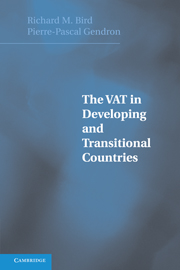Book contents
- Frontmatter
- Contents
- List of Tables
- Preface
- 1 Why This Book?
- 2 The Rise of VAT
- 3 Is VAT Always the Answer?
- 4 Trade and Revenue
- 5 Equity and the Informal Sector
- 6 What Should Be Taxed?
- 7 Key Issues in VAT Design
- 8 New Issues in VAT Design
- 9 Administering VAT
- 10 Dealing with Difficulties
- 11 The Political Economy of VAT
- 12 Where Do We Go from Here?
- Annex
- References
- Index
8 - New Issues in VAT Design
Published online by Cambridge University Press: 16 November 2009
- Frontmatter
- Contents
- List of Tables
- Preface
- 1 Why This Book?
- 2 The Rise of VAT
- 3 Is VAT Always the Answer?
- 4 Trade and Revenue
- 5 Equity and the Informal Sector
- 6 What Should Be Taxed?
- 7 Key Issues in VAT Design
- 8 New Issues in VAT Design
- 9 Administering VAT
- 10 Dealing with Difficulties
- 11 The Political Economy of VAT
- 12 Where Do We Go from Here?
- Annex
- References
- Index
Summary
In recent years, two important new issues have been added to the list of problems facing VAT designers and administrators everywhere – the taxation of electronic commerce and the increasing interest in the possible use of VAT in some form at the subnational level of government. As we noted in Chapter 6 with respect to financial services, what most developing and transitional countries need to do is to get their VATs working properly before they begin to worry about the first of these problems. The second issue – subnational VAT – while of concern mainly to a few large countries (e.g., Brazil and India) is sufficiently important there to warrant close attention.
VAT AND THE DIGITAL ECONOMY
Governments, international organizations, and pundits have over the last few years poured forth reams of paper on how sales taxes should be applied to ‘digital’ sales (or ‘electronic commerce,’ hereafter ‘e-commerce’). The general line most OECD countries have taken on this issue is simple, reasonable, and persuasive: taxation should be neutral and equitable for all forms of commerce, electronic or otherwise, simultaneously minimizing both compliance and administrative costs and the potential for tax evasion and avoidance (Li 2003). But what does the growth of e-commerce imply for VAT in developing and transitional countries?
VAT is a partial solution
To begin with, simply adopting a VAT (compared to any other form of consumption tax) offers a partial solution to the problems posed by digital commerce.
Information
- Type
- Chapter
- Information
- The VAT in Developing and Transitional Countries , pp. 138 - 160Publisher: Cambridge University PressPrint publication year: 2007
